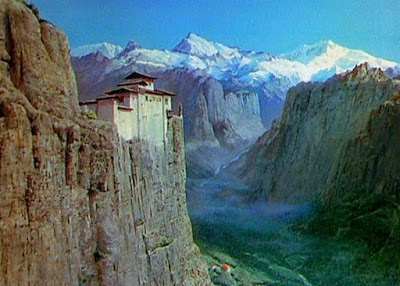 |
| Fig 1: Movie Poster |
 |
| Fig 2: Matte Painting illustrated. |
 |
| Fig 3: Faking the scenery |
After opening a new convent in the Himalayas where they run a school for children and women a group of Nuns encounter conflict with each other and their surroundings. Oppositions run strong as we watch these Nuns struggle between human nature vs rules and conflict in ideals among their group after being exposed to change, their isolated minds that have certain values locked up begin to break free. Working with the natives, the Nuns meet and have business with a man named Mr Dean (played by David Farrar) who in this film is objectified that a couple Nuns (especially Sister Ruth) lust for, as seen in the humorous scene where Dean is standing shirtless, in shorts and Ruth just slides casually into the shot like he’s a magnet pulling her in (see fig 4). Another opposition this film explores is gender expectations, usually it is women being objectified in media however in this film the Nuns are portrayed to be pure (guess that explains why they wear white in contrast to all the colours worn around them by other people) but even then that expectation is challenged starting with when the audience first meet Sister Ruth covered in blood (see fig 5) Dean shows her some kindness which she has longed for and from then on she forms a lust and starts her journey of becoming anew, “From then on, she [Ruth] is more woman than nun. Her white habit, splashed with blood, indicates the sexing of the character. In the same image, menstrual blood and the symbolical loss of virginity are displayed, as they will be again later in the red dress that will replace the uniform and advertise her difference from the rest” (Bagatavicius, 2012).
 |
| Fig 4: Ruth's attraction to Dean. |
 |
| Fig 5: Ruth in blood |
In addition to the colour red giving symbolism in that sense it also gives symbolism of seduction and passion when she wears the red dress and puts on red lipstick and this is emphasised by the big close up shot of her putting on this red lipstick slowly (see fig 6). Red is key character, as well as being the colour of passion, the colour red and passion is linked to anger - both deep emotions that take a lot to awaken so when we watch Ruth get rejected by Dean, we see the anger in her eyes in another big close up and then we see her vision from her point of view where the edges turn red and she passes out. However Ruth is not the only one to face conflict with her values, Sister Philippa requests of her Sister Superior (Sister Clodagh) an immediate transfer out of the convent after she begins loosing faith in her vows. When out planting vegetables Philippa plants flowers instead, flowers are asexual and reproductive this is symbolic again for becoming anew and again sexual connotations are being evoked. “Sexuality is the monster that makes victims of the innocent and wreaks havoc in an otherwise peaceful world.” – (Meyers and Waller). This quote applies to one of the ending scenes where jealousy for Clodagh burns so destructively in Ruth that she tries to kill her by pushing her off a cliff but ends up killing herself in the tranquil Himalayas.
 |
| Fig 6: Ruth's close up lipstick. |
Bibliography:
Bagatavicius, A. (2012) [Online]. At: http://offscreen.com/view/holiness_in_black_narcissus (Accessed on 16 November 2016)
Illustration List:
Figure 1 Movie Poster. Black narcissus movie posters. (1947) [Poster]. At: https://uk.pinterest.com/pin/247557310745885604/ (Accessed on 16 November 2016)
Figure 2 Matte Painted Illustrated. Imgur. (2015) BLACK NARCISSUS (1947) did not use CGI, green screens or projected backdrops to create a vast mountain gully. Here is a before and after shot of a matte painting. At: http://imgur.com/gallery/z107PfS (Accessed on 16 November 2016)
Figure 3 Faking the scenery. Set design - black Narcissus ( 1947 ). At: https://silverscenesblog.blogspot.co.uk/2014/05/set-design-black-narcissus-1947.html (Accessed on 16 November 2016)
Figure 4 Ruth's attraction to Dean. (1947) [Online] At: http://film.thedigitalfix.com/content/id/68122/black-narcissus.html (Accessed on 16 November 2016)
Figure 5 Ruth in Blood. Bagatavicius, A. (2012) [Online]. At: http://offscreen.com/view/holiness_in_black_narcissus (Accessed on 16 November 2016)
Figure 6: Ruth's Close Up Lipstick. Glamourpost. (2012) 1940s makeup – the famous lipstick scene in black Narcissus. At: http://glamourdaze.com/2012/09/1940s-makeup-the-famous-lipstick-scene-in-black-narcissus.html (Accessed on 16 November 2016)

Excellent review once again, Paris :)
ReplyDeleteJust a couple of things... make sure that you italicise all the film titles, and you should also include the date after the film name the first time you mention it, such as King Kong (1933) for example (I can't do italics in the comment box!)
You are also missing a couple of references in the bibliography... the quote from the film needs to be referenced, and also there is one by 'Meyers and Waller'.